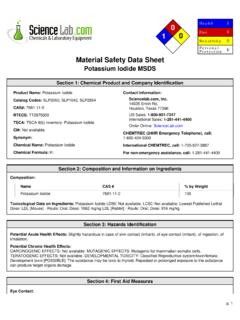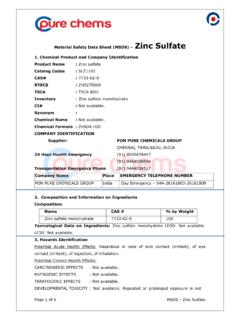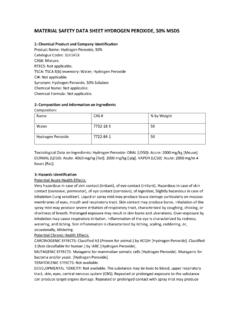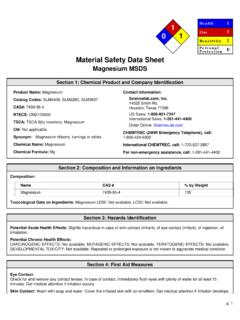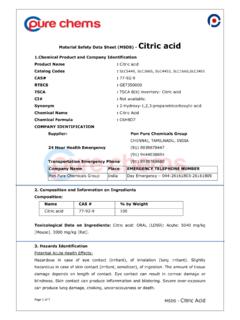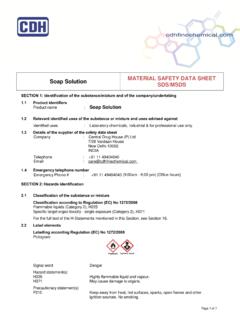Transcription of A MATERIAL SAFETY DATA SHEET POTASSIUM IODIDE
1 A MATERIAL SAFETY data SHEET . POTASSIUM IODIDE . Product Identifiers: Product Name : POTASSIUM IODIDE CAS No : 7681-11-0. Relevant identified uses of the substance or mixture and uses advised against Identified uses : Laboratory chemicals, Manufacture of substances Details of the supplier of the SAFETY data SHEET Supplier: Infinium Pharmachem Pvt. Ltd. (AN ISO 9001:2008 CERTIFIEDCO.). 38, , Sojitra Dist: ANAND. Gujarat, India Tel : 0091-2697-234987. Fax : 0091-2697-234987. Email : Synonyms : Potide; hydriodic acid, POTASSIUM salt; Iodic acid, POTASSIUM salt; POTASSIUM ; Kaliumiodid; Pherajod; Kalii iodidum ;Kali IODIDE ; POTASSIUM IODIDE (KI); POTASSIUM diiodide; Tripotassium triiodide; POTASSIUM IODIDE (JP14/USP);3,4,5-Trihydroxy benzoic acid; POTASSIUM IODIDE 45% Soln; Thyroblock(TN).
2 Knollide;Kisol; Asmofug E;Mudrane Tablets;Yoduro de potasoi; Iodure de POTASSIUM ; Iodure de POTASSIUM CAS No. : 7681-11-0. Molecular Weight : g/mol Chemical Formula : KI. Classification of the substance or mixture Classification according to Regulation (EC) No 1272/2008 [EU-GHS/CLP]. Acute toxicity, Oral (Category 4), H302. Skin irritation (Category 2), H315. Eye irritation (Category 2), H319. For the full text of the H-Statements mentioned in this Section, see Section 16. Classification according to EU Directives 67/548/EEC or 1999/45/EC. Xn Harmful R22. Xi Irritant R36/38. For the full text of the R-phrases mentioned in this Section, see Section 16. Label elements Labeling according Regulation (EC) No 1272/2008. Pictogram Signal word Warning Hazard statement(s). H302 Harmful if swallowed H315 Causes skin irritation.
3 H319 Causes serious eye irritation. Precautionary statement(s). P305 + P351 + P338 IF IN EYES: Rinse cautiously with water for several minutes. Remove contact lenses, if present and easy to do. Continue rinsing. Supplemental Hazard None Statements Other hazards This substance/mixture contains no components considered to be either persistent, bioaccumulative and toxic (PBT), or very persistent and very bioaccumulative (vPvB) at levels of or higher. Description of first aid measures General Advice Consult a physician. Show this SAFETY data SHEET to the doctor in attendance. If inhaled If breathed in, move person into fresh air. If not breathing, give artificial respiration. Consult a physician. In case of skin contact Wash off with soap and plenty of water. Consult a physician.
4 In case of eye contact Rinse thoroughly with plenty of water for at least 15 minutes and consult a physician. If swallowed Never give anything by mouth to an unconscious person. Rinse mouth with water. Consult a physician. Most Important symptoms & efforts, both acute and delayed The most important known symptoms and effects are described in the labelling (see section ) and/or in section 1. Indication of any immediate medical attention and special treatment needed No data available Extinguishing Media: Use water spray, alcohol-resistant foam, dry chemical or carbon dioxide. Special hazards arising from the substance or mixture Hydrogen IODIDE , POTASSIUM oxides. Advice for firefighters Wear self contained breathing apparatus for fighting if necessary. Further Information No data available.
5 Personal precautions, protective equipment and emergency procedures Use personal protective equipment. Avoid dust formation. Avoid breathing vapors, mist or gas. Ensure adequate ventilation. Avoid breathing dust. For personal protection see section 8. Environmental precautions Do not let product enter drains. Methods and materials for containment and cleaning up Pick up and arrange disposal without creating dust. Sweep up and shovel. Keep in suitable, closed containers for disposal. Reference to other sections For disposal see section 13. Precautions for safe Handling Avoid contact with skin and eyes. Avoid formation of dust and aerosols. Provide appropriate exhaust ventilation at places where dust is formed. Conditions for safe Storage, including any incompatibilities Store in cool place.
6 Keep container tightly closed in a dry and well-ventilated place. Air , light and moisture sensitive. Store under inert gas. Storage class (TRGS 510 ): Non combustible solids. Specific end uses Apart from the uses mentioned in section no other specific uses are stipulated Control parameters Components with workplace control Parameters. Exposure Controls Appropriate engineering controls Handle in accordance with good industrial hygiene and SAFETY practice. Wash hands before breaks and at the end of workday. Personal protective equipment Eye/face protection Face shield and SAFETY glasses Use equipment for eye protection tested and approved under appropriate government standards such as NIOSH (US) or EN 166(EU). Skin protection Handle with gloves. Gloves must be inspected prior to use.
7 Use proper glove removal technique (without touching glove's outer surface) to avoid skin contact with this product. Dispose of contaminated gloves after use in accordance with applicable laws and good laboratory practices. Wash and dry hands. The selected protective gloves have to satisfy the specifications of EU Directive 89/686/EEC and the standard EN 374 derived from it. Body Protection Complete suit protecting against chemicals, The type of protective equipment must be selected according to the concentration and amount of the dangerous substance at the specific workplace. Respiratory protection For nuisance exposures use type P95 (US) or type P1 (EU EN 143) particle respirator. For higher level protection use type OV/AG/P99 (US) or type ABEK-P2 (EU EN. 143) respirator cartridges.
8 Use respirators and components tested and approved under appropriate government standards such as NIOSH (US) or CEN (EU). Information on Basic physical & chemical properties a) Appearance Form: crystalline b) Odor no data available c) Odor Threshold no data available d) pH 6 - 9 at 166 g/l at 25 C. e) Melting point/freezing Melting point/range: 681 C. Point f) Initial boiling point and C. Boiling range g) Flash point no data available h) Evaporation rate no data available i) Flammability (solid, gas) no data available j) Upper/lower no data available Flammability or explosive limits k) Vapor pressure 1 hPa at 745 C. l) Vapor density no data available m) Relative density g/cm3. n) Water solubility no data available o) Partition coefficient: n-octanol /water no data available p) Auto ignition no data available Temperature q) Decomposition no data available Temperature r) Viscosity no data available s) Explosive properties no data available t) Oxidizing properties no data available Other SAFETY Information Bulk Density kg/m3.
9 Reactivity no data available Chemical stability May decompose on exposure to air and moisture. Stable under recommended storage conditions. Possibility of hazardous reactions no data available Conditions to avoid Tin / tin oxides. Incompatible materials Strong reducing agents, Nickel, Strong Acids, and its alloys, Steel (all types and surface treatments), Aluminum, Alkali metals, Brass, Magnesium, Zinc, Cadmium, Copper. Hazardous decomposition products Other decomposition products - no data available In the event of fire: see section 5. Information on toxicological effects Acute toxicity LD 50 Oral Mouse mg/kg Skin corrosion/irritation Skin- Rabbit Result: Irritating to skin. Serious eye damage/eye irritation Eyes- Rabbit Result : Irritating to eyes. 24 h (Draize Test).
10 Respiratory or skin sensitization Prolonged or repeated exposure may cause allergic reactions in certain sensitive individuals Germ cell mutagenicity no data available Carcinogenicity IARC: No component of this product presents at levels greater than or equal to is identified as probable, possible or confirmed human carcinogen by IARC. Reproductive toxicity Exposure to excessive amounts of iodine during pregnancy is capable of producing fetal hypothyroidism. Iodine-containing drugs have been associated with fetal goiter. Specific target organ toxicity - single exposure no data available Specific target organ toxicity - repeated exposure no data available Aspiration hazard no data available Additional Information RTECS: TT2975000. Prolonged exposure to iodides may produce iodism in sensitive individuals.
